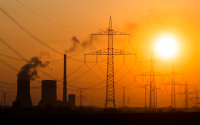22 October 2007USA TodayDoyle Rice
Carbon dioxide — the greenhouse gas considered most responsible for global warming — has been emitted into the Earth's atmosphere at a dramatically accelerating pace since 2000, researchers reported Monday.
"Carbon dioxide is rising at a much faster rate than before," says study co-author Christopher Field, director of the Carnegie Institution's Department of Global Ecology in California. "In the 1990s, CO{-2} emissions increased by about 1.3% per year. Since 2000, the growth rate has been 3.3% per year." The researchers calculate that global carbon-dioxide emissions were 35% higher in 2006 than in 1990.
What's especially troubling, notes lead author Josep Canadell of Australia's Commonwealth Scientific and Industrial Research Organization, is most climate scenarios used by scientists and policymakers to predict temperature increases are based on the 1.3% rise. Greenhouse gases such as carbon dioxide warm the planet by trapping heat in the atmosphere.
Canadell says that while the Intergovernmental Panel on Climate Change predicts "we will have temperature increases of 3.2 to 7.1 degrees by the end of the century, … we're well on the way to the higher temperature increase if the emissions keep going up at this rate."
Higher global temperatures have been predicted to cause rising sea levels, more frequent heat waves and wildfires, and huge losses of ice in the Arctic and Antarctic.
The growing world economy is fueling the emissions. "Our ability to become more carbon-efficient is declining, especially since 2000," Field says. "We're no longer seeing progress in this area, which is probably a reflection of a large amount of coal coming into the power system."
Another factor is the reduced amount of carbon dioxide naturally absorbed by the Earth's land, plants and oceans, known as "carbon sinks." Study co-author Thomas Conway of the National Oceanic and Atmospheric Administration's Earth System Research Laboratory in Boulder, Colo., says, "Carbon sinks were keeping up with the increased emissions, but now they're not."
Canadell confirms this: "We now know that significant contributions to the growth of atmospheric CO{-2} arise from the slowdown" of nature's ability to take the chemical out of the air.
The research was supported by Australian, European and other international agencies.






